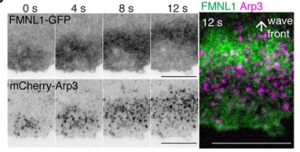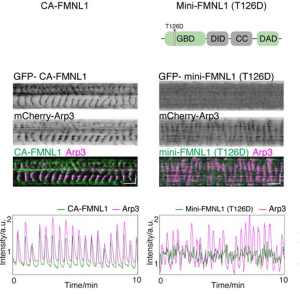Competition and Synergy of Arp2/3 and Formins in Nucleating Actin Waves
Preprint posted on 13 September 2023 https://www.biorxiv.org/content/10.1101/2023.09.13.557508v1.full
Categories: cell biology
Background. Actin dynamics play fundamental roles in various cell biological aspects, ranging from cell division, motility, as well as growth. A peculiar phenomenon of cycling rounds of actin polymerization and disassembly, referred as actin waves, is known to occur in many cell types and has been linked to several processes like migration and plasma membrane rearrangements (Inagaki and Katsuno, 2017). Actin polymerization is orchestrated by two main classes of nucleators, namely Formins and the Arp2/3 complex, which respectively drive elongation of preexisting filaments and formation of new actin branches (Lappalainen et al. 2022). After being described and studied separately for many years, Formins and Arp2/3 are increasingly recognized to work in concert in many circumstances. Still, how their functions are coordinated represent an active area of investigation. In this preprint, the authors employ actin waves as a model to study the interplay between Formins and Arp2/3 in Mast cells. Overall, they found a previously unrecognized synergy between the two classes of nucleators, as well as a competition for the common upstream regulator Cdc42.
Key findings of this preprint
-
Formins precede Arp2/3 in coordinated actin waves
The authors used super-resolution microscopy and various fluorescent reporters for the Formin mDia3 and FMNL1 and the Arp2/3 complex in order to catch a potential oscillatory and coordinated movement of these factors at the plasma membrane. Arp2/3 was recruited in all actin waves analyzed and in a punctate pattern, highlighting its importance and specialized function in this context. When present in the same cortical actin wave, Arp2/3 recruitment was consistently seen to lag behind Formins in the cycling steps of actin waves (Figure 1). The authors suggest that Formin-mediated actin polymerization could act as a trigger by providing preexisting filaments where Arp2/3 could be recruited to nucleate new branches.

| Figure 1 – Live imaging of Formin FMNL1 and Arp3 at cortical waves. |
-
Molecular mechanism of Formins recruitment to waves
To grasp the mechanism of Formin recruitment to the plasma membrane, the authors overexpressed various fluorescent Formin mutants and found that the GTPase binding domain, together with the releasement of the autoinhibited form of the protein are necessary to timely recruit Formins before Arp2/3 and in a rhythmic fashion (Figure 2).

| Figure 2 – Representative picture of kymographs showing actin waves of a constitutively active FMNL1 and a C-terminal FMNL1 portion together with Arp2/3. Releasement from autoinhibition (left) results in well-defined and rhythmic FMNL1 waves, whereas mutation in the GTPase binding domain (right) results in abrogation of a defined pattern of Formin wave. |
-
Requirements for actin nucleator recruitment to waves
Blocking actin dynamics by cytochalasin-D treatment allowed the authors to uncouple actin oscillation from membrane recruitment of actin-nucleator factors. Only the Formins and Arp2/3 upstream regulator Cdc42 was able to maintain membrane recruitment in this condition, whereas waves of Arp2/3, FMNL1 or mDia3 were all abolished, highlighting their need for interaction with actin.
-
Cdc42 competition rather than actin competition dictates waves coordination
Blockade of Arp2/3 activity by CK-666 treatment increased Formin and Cdc42 activity and recruitment to cortical waves. Arp2/3 recruitment dampened Formin-mediated actin polymerization, likely by competing for Cdc42 binding. Indeed, Cdc42 can bind both FMNL1 and WASp (the factor guiding Arp2/3 activity downstream of Cdc42) in a mutually exclusive way. Moreover, Arp2/3 activity was observed to somehow downregulate Cdc42 activity. The authors thus suggested that Arp2/3 recruitment functions as negative feedback to Formin at every cycle of an actin wave by competing for Cdc42 binding and activity.
Why I chose this preprint
Regulation of actin dynamics is a fascinating aspect in cell biology with lots of unanswered questions. The authors used very nice microscopy techniques to get further insights of this process. The evidence provided by the authors challenges the current simplistic view depicting competition between Formins and Arp2/3 for monomer actin and add another layer of complexity by showing Cdc42 as a critical regulator of actin nucleator activities.
Questions to the authors
- Would it be possible to generate fluorescent labelled knock-in to visualize formins and Arp2/3 endogenous localization and activities?
- How could Arp2/3 activity restrain Cdc42 function?
- What has been the most challenging part and what the most exciting part of your work for this story?
References
- Inagaki N., Katsuno H. “Actin Waves: Origin of Cell Polarization and Migration?” (2017), Trends in Cell Biology, 27 (7), pp. 515-526.
- Lappalainen, P., Kotila, T., Jégou, A. et al. “Biochemical and mechanical regulation of actin dynamics”. (2022), Nat Rev Mol Cell Biol 23, 836–852. https://doi.org/10.1038/s41580-022-00508-4
Posted on: 27 October 2023 , updated on: 8 November 2023
doi: https://doi.org/10.1242/prelights.35841
Read preprintSign up to customise the site to your preferences and to receive alerts
Register hereAlso in the cell biology category:
Fetal brain response to maternal inflammation requires microglia
Alteration of long and short-term hematopoietic stem cell ratio causes myeloid-biased hematopoiesis
Clusters of lineage-specific genes are anchored by ZNF274 in repressive perinucleolar compartments
preLists in the cell biology category:
BSCB-Biochemical Society 2024 Cell Migration meeting
This preList features preprints that were discussed and presented during the BSCB-Biochemical Society 2024 Cell Migration meeting in Birmingham, UK in April 2024. Kindly put together by Sara Morais da Silva, Reviews Editor at Journal of Cell Science.
| List by | Reinier Prosee |
‘In preprints’ from Development 2022-2023
A list of the preprints featured in Development's 'In preprints' articles between 2022-2023
| List by | Alex Eve, Katherine Brown |
preLights peer support – preprints of interest
This is a preprint repository to organise the preprints and preLights covered through the 'preLights peer support' initiative.
| List by | preLights peer support |
The Society for Developmental Biology 82nd Annual Meeting
This preList is made up of the preprints discussed during the Society for Developmental Biology 82nd Annual Meeting that took place in Chicago in July 2023.
| List by | Joyce Yu, Katherine Brown |
CSHL 87th Symposium: Stem Cells
Preprints mentioned by speakers at the #CSHLsymp23
| List by | Alex Eve |
Journal of Cell Science meeting ‘Imaging Cell Dynamics’
This preList highlights the preprints discussed at the JCS meeting 'Imaging Cell Dynamics'. The meeting was held from 14 - 17 May 2023 in Lisbon, Portugal and was organised by Erika Holzbaur, Jennifer Lippincott-Schwartz, Rob Parton and Michael Way.
| List by | Helen Zenner |
9th International Symposium on the Biology of Vertebrate Sex Determination
This preList contains preprints discussed during the 9th International Symposium on the Biology of Vertebrate Sex Determination. This conference was held in Kona, Hawaii from April 17th to 21st 2023.
| List by | Martin Estermann |
Alumni picks – preLights 5th Birthday
This preList contains preprints that were picked and highlighted by preLights Alumni - an initiative that was set up to mark preLights 5th birthday. More entries will follow throughout February and March 2023.
| List by | Sergio Menchero et al. |
CellBio 2022 – An ASCB/EMBO Meeting
This preLists features preprints that were discussed and presented during the CellBio 2022 meeting in Washington, DC in December 2022.
| List by | Nadja Hümpfer et al. |
Fibroblasts
The advances in fibroblast biology preList explores the recent discoveries and preprints of the fibroblast world. Get ready to immerse yourself with this list created for fibroblasts aficionados and lovers, and beyond. Here, my goal is to include preprints of fibroblast biology, heterogeneity, fate, extracellular matrix, behavior, topography, single-cell atlases, spatial transcriptomics, and their matrix!
| List by | Osvaldo Contreras |
EMBL Synthetic Morphogenesis: From Gene Circuits to Tissue Architecture (2021)
A list of preprints mentioned at the #EESmorphoG virtual meeting in 2021.
| List by | Alex Eve |
FENS 2020
A collection of preprints presented during the virtual meeting of the Federation of European Neuroscience Societies (FENS) in 2020
| List by | Ana Dorrego-Rivas |
Planar Cell Polarity – PCP
This preList contains preprints about the latest findings on Planar Cell Polarity (PCP) in various model organisms at the molecular, cellular and tissue levels.
| List by | Ana Dorrego-Rivas |
BioMalPar XVI: Biology and Pathology of the Malaria Parasite
[under construction] Preprints presented at the (fully virtual) EMBL BioMalPar XVI, 17-18 May 2020 #emblmalaria
| List by | Dey Lab, Samantha Seah |
1
Cell Polarity
Recent research from the field of cell polarity is summarized in this list of preprints. It comprises of studies focusing on various forms of cell polarity ranging from epithelial polarity, planar cell polarity to front-to-rear polarity.
| List by | Yamini Ravichandran |
TAGC 2020
Preprints recently presented at the virtual Allied Genetics Conference, April 22-26, 2020. #TAGC20
| List by | Maiko Kitaoka et al. |
3D Gastruloids
A curated list of preprints related to Gastruloids (in vitro models of early development obtained by 3D aggregation of embryonic cells). Updated until July 2021.
| List by | Paul Gerald L. Sanchez and Stefano Vianello |
ECFG15 – Fungal biology
Preprints presented at 15th European Conference on Fungal Genetics 17-20 February 2020 Rome
| List by | Hiral Shah |
ASCB EMBO Annual Meeting 2019
A collection of preprints presented at the 2019 ASCB EMBO Meeting in Washington, DC (December 7-11)
| List by | Madhuja Samaddar et al. |
EMBL Seeing is Believing – Imaging the Molecular Processes of Life
Preprints discussed at the 2019 edition of Seeing is Believing, at EMBL Heidelberg from the 9th-12th October 2019
| List by | Dey Lab |
Autophagy
Preprints on autophagy and lysosomal degradation and its role in neurodegeneration and disease. Includes molecular mechanisms, upstream signalling and regulation as well as studies on pharmaceutical interventions to upregulate the process.
| List by | Sandra Malmgren Hill |
Lung Disease and Regeneration
This preprint list compiles highlights from the field of lung biology.
| List by | Rob Hynds |
Cellular metabolism
A curated list of preprints related to cellular metabolism at Biorxiv by Pablo Ranea Robles from the Prelights community. Special interest on lipid metabolism, peroxisomes and mitochondria.
| List by | Pablo Ranea Robles |
BSCB/BSDB Annual Meeting 2019
Preprints presented at the BSCB/BSDB Annual Meeting 2019
| List by | Dey Lab |
MitoList
This list of preprints is focused on work expanding our knowledge on mitochondria in any organism, tissue or cell type, from the normal biology to the pathology.
| List by | Sandra Franco Iborra |
Biophysical Society Annual Meeting 2019
Few of the preprints that were discussed in the recent BPS annual meeting at Baltimore, USA
| List by | Joseph Jose Thottacherry |
ASCB/EMBO Annual Meeting 2018
This list relates to preprints that were discussed at the recent ASCB conference.
| List by | Dey Lab, Amanda Haage |











 (No Ratings Yet)
(No Ratings Yet)